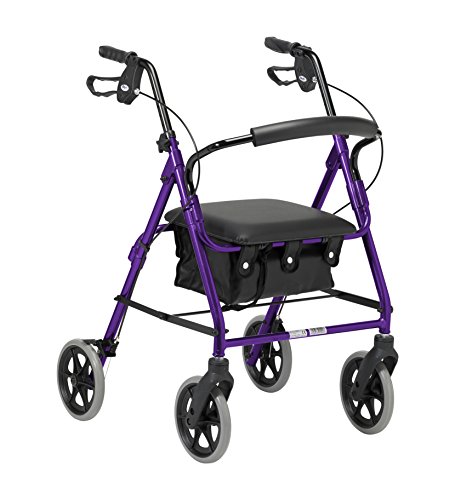How To Know The Rollator Folding To Be Right For You
페이지 정보

본문
 Locking Mechanism For Use With a Foldable Rollator
Locking Mechanism For Use With a Foldable RollatorMost rollators are equipped with a locking mechanism or latch that prevents them from slamming during storage. This is crucial to avoid a potentially hazardous situation during transport.
The lock is situated in the middle of the frame. It can be a button or lever. It is crucial to know how to use this feature.
How to Fold a Rollerator
rollators for seniors are highly effective mobility aids for those who require support and stability when walking. They are lightweight and convenient, and various models are available to meet the needs of different people and budgets. 1 However, some people might be worried about how to fold and unfold a rollator in order to use it safely.
Most modern all-terrain rollators have easy-to-use mechanisms for folding. The walkers fold quickly without the need for any tools. This makes them ideal for storage and transportation. The locking mechanism ensures that the walker won't fall open during transport or storage and offers users security and safety.
Modern nova rollator walkers aren't just easy to fold, but have ergonomic designs that ensure the user's comfort and safety. For instance, they feature comfortable handles, a large basket, and a built-in brake lever to prevent accidental activation. Additionally they are constructed of lightweight materials to guarantee the ability to move around and are easy to handle.
The traditional rollators weigh more and don't fold themselves to support themselves. This makes them difficult to transport or store. The seats are also connected to the frame which means they cannot be stored against objects or narrow spaces. It is essential that those who use rollators know how fold them for easy storage and transport.
The first step in folding the rollator is to locate the locking mechanism, which is typically located near the center of the device's frame. Once you have located it then gently lift or let it go according to the instructions provided by the manufacturer. Once the locking mechanism is removed you can fold your walker by pushing the sides in tandem while holding the releases. Continue folding the walker until it's tightly locked and compacted.
In addition to making sure that the lock is securely in place and that the lock is secure, you should also check your walker for loose parts and indications of wear or damage. If you spot any issues make sure you repair them immediately to prevent further damage and injuries. It is also recommended to regularly lubricate all terrain walker rollators moving parts of the walker in order to reduce friction and ensure the smooth operation.
The Crossbar
The crossbar is a bar that is used to support the frame and wheels of the Designer Rollator; Https://Menwiki.Men/Wiki/Why_Youll_Definitely_Want_To_Read_More_About_Rollator_Walking_Aid,. The crossbar is typically constructed of metal and connects the handlebars with the frame's bottom. The crossbar provides added strength and stability, and also holds the walker's basket as well as other attachments. Many manufacturers offer additional accessories, like baskets for storage and a tote bag for their walker models. They can be positioned on the front or the back of the walker, or placed under the seat.
Many models of walker have an adjustable crossbar that folds in two directions, making them much easier to carry and store. This is an important feature, particularly if the walker will be often used for travel, or long journeys to the grocery store or other places. Additionally, certain walker models come with a removable carry bag for additional storage space.
The brakes are another important element of a rolling walker. They are typically found on the handles and crossbar. There are a variety of brake systems, including cable loop and push-down. To stop the walker from moving the user needs to apply downward pressure to the spring-loaded frame. This kind of system is not suitable for people with smaller feet who might struggle to engage the brakes or for heavier users who might accidentally activate the brakes.
The cable loop brake is more similar to the brakes of bicycles. The cable loop brake system can be activated by simultaneously squeezing both handlebars using both hands. This type of brake system offers greater control and is suited for individuals with limited hand function.
Crossbar can also refer to an vertical stroke that intersects two other strokes within a letterform. The length, thickness, and location of a crossbar can affect the legibility of a particular letterform and is a major distinction between serif and non-serif fonts. The crossbar on the small letter e is often called an arm.
The Release Mechanisms
Rollators are a great way to increase mobility and independence for people who are physically challenged. This unique stability device helps distribute the weight evenly across the user's lower body, reducing stress on muscles and joints which allows for a smooth and comfortable movement. These mobility aids are equipped with customizable features such as brakes and handlebars that can be adjusted, built-in seating, and storage compartments. They let users move around with ease and with confidence. These lightweight mobility aids that are portable can be covered by Medicare and Medicaid to make them more affordable.
In contrast to traditional walkers, which come with a basket and a seat and must be stowed in the trunk of your car, carbon rollators fold down to allow to make it easy to transport them in your car or for compact storage. To do this, you need to remove the basket from the frame and pull up the crossbar. This will reveal pair release mechanisms on each side. Then, press the release mechanisms and push the frame sides together until the walking device shrinks to its smaller size.
The locking assembly attaches to a top, substantially horizontal support arm 218 which joins the two vertically inclined tubular legs for the front and rear 220 and 228, respectively. Releasably connected to the ends of the rear and front tubular legs are tubular leg extensions that telescoping 226 and 228 respectively. Telescoping extensions can be rotated between an unlocked and locked position to alter the height of the rolling aid.
When the leg extensions are in the proper place the non-sliding handgrip is connected to the end of the lever that is actuated. The lever that actuates the housing by way of an extension portion that extends from the frame and an recessed piece that is sized to accept the extension piece. The recessed portion and the extension piece provide an axis on which the actuating mechanism can be pivoted.
Once the telescoping leg segments are in the appropriate position, the locking mechanism engages a snap button and biasing spring (not shown). This arrangement allows for the user to simply engage or detach the folding mechanism, which allows for easy storage and transportation of the walking aid.
The Locking Mechanism
The present invention is a locking mechanism that can be used with the foldable rollator or walker. The invention addresses a need for a lock assembly for use with such walkers and rollators that is relatively easy to adjust between folded and unfolded positions for those who be unable to move their hands.
Typically, the gadget comprising two spaced side frames and an interlocking cross brace that connects them is comprised of two handle bars. Two hand brakes are fixated to the handles. Each has a pin-actuating plunger which engages with an actuating plunger located on the cross bar. When the user presses the hand brakes, the pin-actuating plunger is depressed, thereby causing the side frame to fold into a position.
One issue that comes with this kind of device is that the actuating lever must be held in place by a hand while attempting to depress the plunger that is actuated by the pin. This can be problematic for persons with limited hand strength and/or dexterity. The present invention addresses this problem by including an assembly for locking that is operatively coupled with the lever for actuation.
As shown in FIG. 2. The locking assembly comprises a first body part that has a bore through which extends a locking pin and a second part that is rigidly connected to the first body part. A lock plate is located within the bore. It has an opening that can receive the locking end of the locking pin. A portion of the actuating lever between the handle that applies force end and the body attaching portion is arranged to pivot with respect to both body parts so that the locking pin is moved from a position where it prevents the rotation of the tubular leg, and a position where the leg extension that is telescoping can be extended.
 When the actuating lever is operated by the hands of the user the locking pin gets moved from the first position to the second. As a result, the leg extension that telescoping is able to be removed from the side frame and thereby turns it into its folded position. This can be done when the hand of the user is still securely gripping the handgrip 24 on the side frame. This feature can significantly reduce the amount of effort required to fold a rollator into and out of its folded position.
When the actuating lever is operated by the hands of the user the locking pin gets moved from the first position to the second. As a result, the leg extension that telescoping is able to be removed from the side frame and thereby turns it into its folded position. This can be done when the hand of the user is still securely gripping the handgrip 24 on the side frame. This feature can significantly reduce the amount of effort required to fold a rollator into and out of its folded position.- 이전글Tarot Reading 24.10.31
- 다음글20 Fun Informational Facts About Walking Rollator 24.10.31
댓글목록
등록된 댓글이 없습니다.

